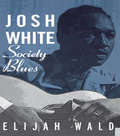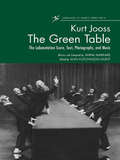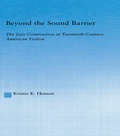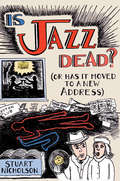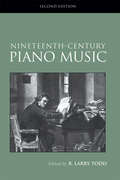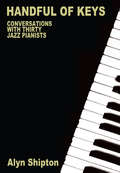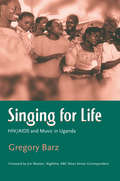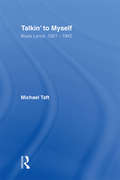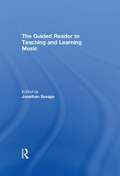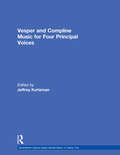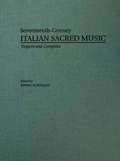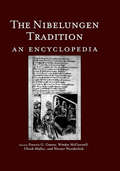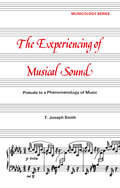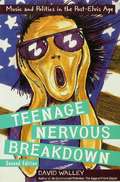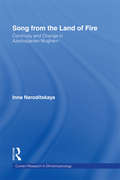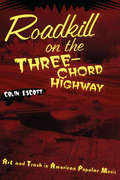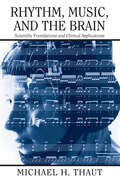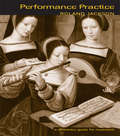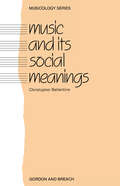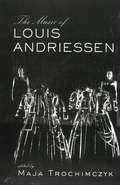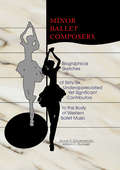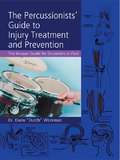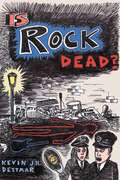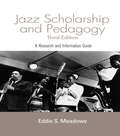- Table View
- List View
Josh White: Society Blues
by Elijah WaldFirst Published in 2002. Routledge is an imprint of Taylor & Francis, an informa company.
The Green Table: The Labanotation Score, Text, Photographs, and Music
by Ann Hutchinson Guest* Score, photographs, and production details of one of this century's best-loved ballets * Includes rare archival material * Packaged with audio CD This work brings together the complete dance score of The Green Table--one of the most famous ballets of the 20th century--in Labanotation, along with music notation for the piano accompaniment and a complete recording of the accompaniment on CD. It also includes several essays about the work and its genesis, and many historic production photographs. This book is an important item for all colleges with dance programs to own in their libraries and for scholars interested in the study of contemporary dance.
Beyond the Sound Barrier: The Jazz Controversy in Twentieth-Century American Fiction (Literary Criticism and Cultural Theory)
by Kristin K HensonBeyond the Sound Barrier examines twentieth-century fictional representations of popular music-particularly jazz-in the fiction of James Weldon Johnson, F. Scott Fitzgerald, Langston Hughes, and Toni Morrison. Kristin K. Henson argues that an analysis of musical tropes in the work of these four authors suggests that cultural "mixing" constitutes one of the central preoccupations of modernist literature. Valuable for any reader interested in the intersections between American literature and the history of American popular music, Henson situates the literary use of popular music as a culturally amalgamated, boundary-crossing form of expression that reflects and defines modern American identities.
Is Jazz Dead?: Or Has It Moved to a New Address
by Stuart NicholsonIs Jazz Dead? examines the state of jazz in America at the turn of the twenty-first century. Musicians themselves are returning to New Orleans, Swing, and Bebop styles, while the work of the '60s avant-garde and even '70s and '80s jazz-rock is roundly ignored. Meanwhile, global jazz musicians are creating new and exciting music that is just starting to be heard in the United States, offering a viable alternative to the rampant conservatism here. Stuart Nicholson's thought-provoking book offers an analysis of the American scene, how it came to be so stagnant, and what it can do to create a new level of creativity. This book is bound to be controversial among jazz purists and musicians; it will undoubtedly generate discussion about how jazz should grow now that it has become a recognized part of American musical history. Is Jazz Dead? dares to ask the question on all jazz fan's minds: Can jazz survive as a living medium? And, if so, how?
Nineteenth-Century Piano Music
by R. Larry ToddFirst Published in 2004. Routledge is an imprint of Taylor & Francis, an informa company.
Handful of Keys: Conversations with 30 Jazz Pianists (Popular Music History Ser.)
by Alyn ShiptonFirst Published in 2005. Routledge is an imprint of Taylor & Francis, an informa company.
Singing For Life: HIV/AIDS and Music in Uganda
by Gregory BarzEfforts within the past decade to address the HIV/AIDS pandemic in sub-Saharan Africa have dealt with HIV/AIDS principally as a medical concern—despite the fact that doctors continue to be confronted with the complex relationship of the disease to broader social issues. When medical and governmental institutions fail, artists step in. Contemporary performances in Uganda often focus on gender and health-related issues specific to women and youths, in which song texts warn against risky sexual environments or unprotected sexual behavior. Music, dance, and drama are principal tools of local initiatives that disseminate information, mobilize resources, and raise societal consciousness regarding issues related to HIV/AIDS. Through case studies, song texts, interviews, and testimonies, Singing for Life: HIV/AIDS and Music in Uganda examines the links between the decline in Uganda’s infection rate and grassroots efforts that make use of music, dance, and drama. Only when supported and encouraged by such performances drawing on localized musical traditions have medical initiatives taken root and flourished in local healthcare systems. Gregory Barz shows how music can be both a mode of promoting health and a force for personal therapy, presenting a cultural analysis of hope and healing.
Popular Music Genres: An Introduction (Edinburgh University Press Ser.)
by Ron Moy Stuart BorthwickAn accessible introduction to the study of popular music, this book takes a schematic approach to a range of popular music genres, and examines them in terms of their antecedents, histories, visual aesthetics, and sociopolitical contexts. Within this interdisciplinary and genre-based focus, readers will gain insights into the relationships between popular music, cultural history, economics, politics, iconography, production techniques, technology, marketing, and musical structure.
Talkin' to Myself: Blues Lyrics, 1921-1942
by Michael TaftTalkin' to Myself: Blues Lyrics, 1921-1942 is a compendium of lyrics by the great blues recording artists of the classic blues era. It includes over 2000 songs, transcribed directly from the original recordings, making it by far the most comprehensive and accurate collection of blues lyrics available.
The Guided Reader to Teaching and Learning Music
by Jonathan SavageThe Guided Reader to Teaching and Learning Music draws on extracts from the published work of some of the most influential education writers to provide insight, guidance and clarity about key issues affecting Music teachers. The book brings together key extracts from classic and contemporary writing and contextualises these in both theoretical and practical terms. The extracts are accompanied by a summary of the key ideas and issues raised, questions to promote discussion and reflective practice, and annotated further reading lists to extend thinking. Taking a thematic approach and including a short introduction to each theme, the chapters cover: ? Analysing your own work as a music teacher; Concepts of musicality; Notions of musical development and progression; Pedagogies for teaching music musically; Music inside and outside the school; Formal, informal and non-formal approaches to music education; Productive methods of assessment and transition for music education; Creativity and music education; Supporting the gifted and talented in music; Using ICT within music education. ? Aimed at trainee and newly qualified teachers including those working towards Masters-level qualifications, as well practicing teachers, this accessible, but critically provocative text will be an essential resource for all teachers that wish to deepen their understanding of Music Education.
Vesper and Compline Music for Four Principal Voices: Agostino Agazzari, Giovanni Francesco Anerio, Giovanni Battista Biondi da Cesena, Maurizio Cazzati, Antonio Cifra, Chiara Margarita Cozzolani, Bonifazio Graziani, Giovanni Legrenzi, Isabella Leonarda, Tarquinio Merula, Lodovico Viadana (Seventeenth Century Italian Sacred Music In Twenty Five Ser. #14)
by Jeffrey Kurtzman Anne SchnoebelenFirst published in 1998. Routledge is an imprint of Taylor & Francis, an informa company.
Vesper and Compline Music for Five Principal Voices, Part I (Variorum Collected Studies #1041)
by Jeffrey KurtzmanThis volume is part of a series of 25 full-score volumes of 17th-century Italian sacred music, a repertoire that has largely been unavailable for study or performance. It includes a comprehensive historical and biographical introduction, focuses on composers significant in their own time, and offers modern notation for contemporary performers.
The Nibelungen Tradition: An Encyclopedia (Reference Library Of The Humanities)
by Francis G. Gentry Winder McConnell Ulrich Muller Werner WunderlichWithin the English-speaking world, no work of the German High Middle Ages is better known than the Nibelungenlied, which has stirred the imagination of artists and readers far beyond its land of origin. Its international influence extends from literature to music, art, film, politics and propaganda, psychology, archeology, and military history.Now
Experiencing of Musical Sound: A Prelude to a Phenomenology of Music (Musicology)
by F. J. SmithFirst Published in 1979. Routledge is an imprint of Taylor & Francis, an informa company.
Teenage Nervous Breakdown: Music And Politics In The Post-elvis Age
by David WalleyTeenage Nervous Breakdown: Music and Politics in the Post-Elvis Era combines music and cultural history and criticism to examine how rock and the rock lifestyle have been merchandised first to a teenage audience and eventually to a worldwide consumer society. Well-known, iconoclastic writer/ critic David Walley examines the entire rock culture and
Song from the Land of Fire: Azerbaijanian Mugam in the Soviet and Post-Soviet Periods (Current Research In Ethnomusicology: Outstanding Dissertations Ser. #6)
by Inna NaroditskayaSong from the Land of Fire explores Azerbaijanian musical culture, a subject previously unexamined by American and European scholars. This book contains notations of mugham performance--a fusion of traditional poetry and musical improvisation--and analysis of hybrid genres, such as mugham-operas and symphonic mugham by native composers. Intimately
Roadkill on the Three-Chord Highway: Art and Trash in American Popular Music
by Colin EscottIt's the real stories, not the publicists' confections, that concern Colin Escott. We hear Perry Como's story in his own words: it wasn't all smooth. We learn about the astonishing twists and turns in Roy Orbison's life, and the stories behind the songs we know so well. And we go down with Vernon Oxford, the last great honky tonk singer, who came to Nashville just a little too late. These are stories for anyone who loves what Escott calls "little songs from great sorrows." They will fascinate even the most casual fan of popular music, and they're told here in sympathetic, engaging, and illuminating prose.
Rhythm, Music, and the Brain: Scientific Foundations and Clinical Applications
by Michael ThautWith the advent of modern cognitive neuroscience and new tools of studying the human brain "live," music as a highly complex, temporally ordered and rule-based sensory language quickly became a fascinating topic of study. The question of "how" music moves us, stimulates our thoughts, feelings, and kinesthetic sense, and how it can reach the human experience in profound ways is now measured with the advent of modern cognitive neuroscience. The goal of Rhythm, Music and the Brain is an attempt to bring the knowledge of the arts and the sciences and review our current state of study about the brain and music, specifically rhythm. The author provides a thorough examination of the current state of research, including the biomedical applications of neurological music therapy in sensorimotor speech and cognitive rehabilitation. This book will be of interest for the lay and professional reader in the sciences and arts as well as the professionals in the fields of neuroscientific research, medicine, and rehabilitation.
Performance Practice: A Dictionary-Guide for Musicians
by Roland JacksonPerformance practice is the study of how music was performed over the centuries, both by its originators (the composers and performers who introduced the works) and, later, by revivalists. This first of its kind Dictionary offers entries on composers, musiciansperformers, technical terms, performance centers, musical instruments, and genres, all aimed at elucidating issues in performance practice. This A-Z guide will help students, scholars, and listeners understand how musical works were originally performed and subsequently changed over the centuries. Compiled by a leading scholar in the field, this work will serve as both a point-of-entry for beginners as well as a roadmap for advanced scholarship in the field.
Music and Its Social Meanings (Musicology #2)
by Christopher BallantineFirst Published in 1984. Routledge is an imprint of Taylor & Francis, an informa company.
Music of Louis Andriessen (Studies In Contemporary Music And Culture Ser.)
by Maja TrochimczykThis book presents the musician in dialog with a Polish-Canadian musicologist and three of his Dutch friends and collaborators, Reinbert de Leeuw, Elmer Schönberger and Frits van der Waa. Topics include his artistic evolution, his relationship to minimalism, his prevalent interest in mysticism and meaning, the use of quotation and writing for
Minor Ballet Composers: Biographical Sketches of Sixty-Six Underappreciated Yet Significant Contributors to the Body of West
by William E Studwell Bruce R SchuenemanWhile most music lovers are familiar with the famous scores of Tchaikovsky, Delibes, and Stravinsky, many other lesser-known composers also wrote for the ballet. Several of these composers wrote almost exclusively for the ballet--and all enriched the world of dance. Minor Ballet Composers presents biographical sketches of 66 underappreciated ballet composers of the 19th and 20th centuries from around the world, along with selected stories from the ballets they helped create. While the composers’contributions to ballet music are emphasized, all aspects of their lives and works are touched upon. Plot summaries and excerpts from reviews of many of the ballets are also provided. Other topics of interest you’ll find covered in Minor Ballet Composers include: Les Six: Darius Milhaud, Louis Durey, Georges Auric, Arthur Honegger, Francis Poulenc, and Germaine Tailleferre--and their relationship with Erik Satie and Jean Cocteau how politics, revolutions, and wars have affected composers and their works who studied with whom; who collaborated with whom schools, movements, and musical renaissance the importance of opera to ballet music the relationship between film scores and ballet music which books, plays, stories, and folk tales certain ballets are based upon where many of these ballets premieredMinor Ballet Composers emphasizes the importance of second-tier composers and their influence on the rich tradition of music written for the dance (though in some cases the music was appropriated for the ballet from other original designs). The gathering of these composers in a single volume in appreciation of their ballet music, with a glossary of choreographers and an index of ballet titles, makes this book a useful volume for ballet aficionados, music librarians, musicians, and others interested in dance and dance music.
The Percussionists' Guide to Injury Treatment and Prevention: The Answer Guide to Drummers in Pain
by Dr. Darin WorkmanPain and injury are near constant companions for professional musicians. Aching hands, painful joint swelling, back problems, among other ailments were all thought to be part of the price musicians had to pay to be performers. However, thanks to an increasing awareness of both the kinesiology and biology of movement, as well as proper techniques for fostering good performance habits, musicians no longer have to suffer in silence.Perhaps no group of musicians has been more prone to career-threatening injury than percussionists, and the demands for speed, power, control, and endurance are only increasing. Often musicians wait until an injury is so aggravated that it's too late to be fully treated. In almost every case, if the drummer had done some very simple preventative (or early) care, the injury would never have become a serious issue.The Percussionists' Guide to Injury Treatment and Prevention is designed to aid in that early prevention and treatment. Although it is not a substitute for clinical diagnosis or medical care from a trained physician, it can educate the musician as to how the human body works; the role of muscles and skeletal structure in supporting movement; and understanding specifically how to prevent and treat common injuries. The book begins with a general discussion of how the body works and basic prevention concepts. It then covers each specific area of the body (where it hurts), suggesting practical ways to prevent and treat it. Basic anatomy is covered in terms that a musician can understand.For all percussion students and professionals, The Percussionists' Guide to Injury Treatment and Prevention will be an indispensable companion.
Is Rock Dead?
by Kevin J.H. DettmarRock and roll's death has been forecast nearly since its birth; the country song "The Death of Rock and Roll" appeared in September 1956, showing that the music had already outraged a more conservative listening audience. Is Rock Dead? sets out to explore the varied and sometimes conflicting ways in which the death of rock has been discussed both within the discourse of popular music and American culture. If rock is dead, when did it die? Who killed it? Why do rock journalists lament its passing? Has its academic acceptance stabbed it in the back or resuscitated an otherwise lifeless corpse? Why is rock music the music that conservatives love to hate? On the other side of the coin, how have rock's biggest fans helped nail shut the coffin? Does rock feed on its own death-and-rebirth? Finally, what signs of life are there showing that rock, in fact, is surviving?Is Rock Dead? will appeal to all those who take seriously the notion that rock is a serious musical form. It will appeal to students of popular music and culture, and all those who have ever spun a 45, cranked up the radio, or strummed an air guitar.
Jazz: Research and Pedagogy (Routledge Music Bibliographies #No. 4)
by Eddie S. MeadowsJazz: Research and Pedagogy is the third edition of an annotated bibliography to books, recordings, videos, and websites in the field of jazz. Since the publication of the 2nd edition in 1995, the quantity and quality of books on jazz research, performance, and teaching materials have increased. Although the 1995 book was the most comprehensive annotated jazz bibliography published to that date, several books on research, performance, and teaching materials were omitted. In addition, given the proliferation of new books in all jazz areas since 1995, the need for a new, comprehensive, and annotated reference book on jazz is apparent. Multiply indexed, this book will serve as an excellent tool for librarians, researchers, and scholars in sorting through the massive amount of new material that has appeared in the field over the last decade.
